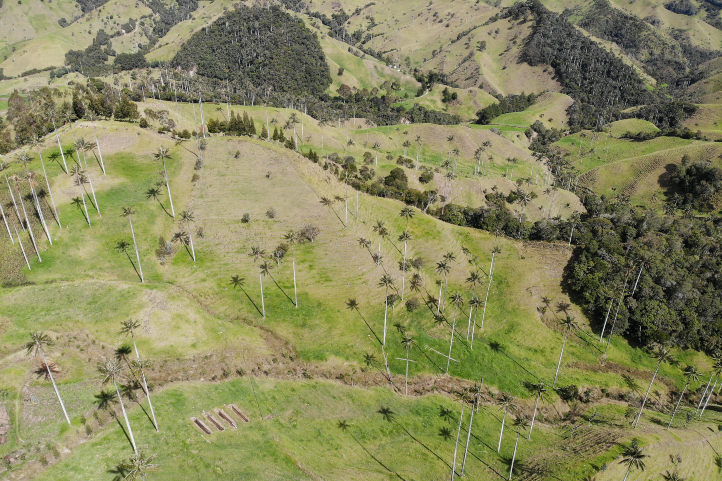Slow cities in Colombia: Pijao, at the Coffee Triangle
Pijao is a quiet and unexplored natural destination, and the first Cittaslow town in Colombia. A Cittaslow town is a community-managed system of continuous improvement with a sustainable outcome that strives for quality of life for its residents.
Pijao is a town with a coffee architecture tradition that stopped in time, as well as the church clock, with a long tower and with little grace, painted in pale orange that stopped at 7:25 minutes, one day, many years ago.
Discovering Pijao Cittaslow
It is located in the west of the department of Quindio on the central mountain range at 1700 meters above sea level, and has no more than 6,800 inhabitants.
At the village entrance there is an arch of raw brick columns with a chipped statue of Virgin Mary; when you are in the center of the village you will notice that the people live without worries.
In addition, Pijao has a high Andean forest ecosystem and Páramo; in the Páramo the rivers Lejos and Azul are the source of the town’s water supply and its average temperature is 23°C (73º F).
How to get to Pijao
Take a 1,5-hours flight from El Dorado (BOG) in Bogotá to El Edén International Airport (AXM) at Armenía city. Once at the airport, take an approximately 1-hour ride to Pijao
Where to stay in Pijao
When in Pijao you will feel part of the town, as the facades of the hotels are very traditional and you will feel like you are in another era. There are few lodging options and we recommend you to stay at Finca el Otoño.
Activities and attractions in Pijao Cittaslow
Tour of the town
We recommend that you start your tour in the central park, from there you can have a panoramic view of the houses where you will fall in love with its beautiful architecture and colors.
Then you can visit the town hall which looks like an anthropological museum, in fact, it is in a way.
Moreover, you can visit the church of San Jose which has a very particular structure, the colors contrast with the architecture of the square and its clock tower preserves the original structure.
La Floresta Coffee Shop
This cozy coffee shop despite its humble appearance has a space where you can live a wonderful coffee experience; where you can learn the methods of filtering and preparation. They gave us a live demonstration of the chemex method and we did a tasting of different types of coffee, both hot and cold.
Bar Los Recuerdos
The owner of this bar, Gonzalo, over the last 50 years has collected about 3,000 photographs and posters of Argentine, Spanish, Colombian and Mexican artists, which adorn the walls and ceilings of this magical place.
Inside the bar you can observe the collection of more than 2,000 vinyl records of boleros, rancheras, pasillos and tangos, which play in a 33 and 45 revolutions player.
Pijao Social Bar
Enjoy a delicious cup of coffee in the only steam-powered ink machine in Quindío that is more than 70 years old. While enjoying your coffee you can play pool with the locals and listen to the anecdotes of this historic bar.
Contemplate the sunset in “the place where the herons arrive”
Just 20 meters from the central square you will find a tree where every day hundreds of herons and other birds come to rest, including those flying away from the North American winter.
Mountain biking through the Paramo de Chili
If you have previous experience in mountain biking you will love this activity, 28 kilometers of biking from Pijao you can live a unique and unforgettable experience where you will overcome your limits until you reach 3,750 meters above sea level.
This tour has a duration of 7 hours and its degree of difficulty is high.
Excursion to the Mellizas Lagoon
If you want to know a hidden place of Los Nevados Natural Park, if you like trekking and hiking this plan is for you. During 6 hours of hiking with a medium-low degree of difficulty in the middle of swampy paths but of special beauty.
During the tour you will be able to observe a great diversity of birds, trout and frailejones and discover 7 additional lagoons that are little known by the visitors of the Natural Park of Los Nevados.
Coffee Experience
In the rural zone of Pijao it is possible to take tours of the coffee plantations. You will have a tour of the coffee process from the beginning, exploring from the coffee plantations to the coffee roasting and grinding process.
Finally, you will be able to enjoy a delicious cup of high-quality coffee, due to the soil conditions and the processes that the farmers of the town manage.
Tour to the Wax Palm Forest
Initially you must have a local guide to carry-out this activity. The first trail you take goes to the farm La Playa, where you can have breakfast and from there you will reach the school of Vereda Las Palmas. his point can be reached by motorcycle, jeep or bike before starting the ascent on foot.
During 40 minutes of walking at more than 3200 meters above sea level you will be surrounded by the imposing and beautiful wax palms, until you reach the farm El Alto. There you can have a hot snack or lunch while you contemplate the beauty of the mountains decorated by the enormous amount of wax palms.
It is recommended that you wear warm and waterproof clothes, if possible bring a change of clothes in case of rain.
If you want to know more about Colombia, or wants to book your trip, please contact us.
References
About the author
Luisa Martin
Engineer, world traveler, amateur photographer, traveling blogger, and foody.
